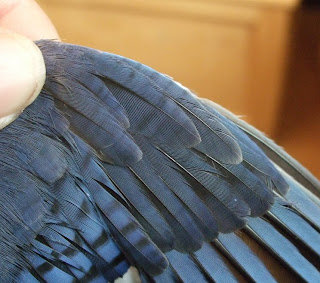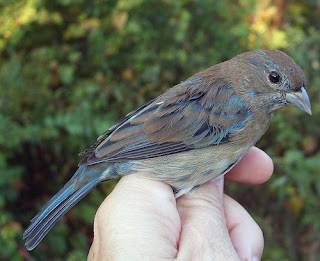We banded all 7 days of week #8 (3-9 Oct), but several days were shortened by having to replace nets destroyed by deer. The deer herd on campus has gotten so large that we had to resort to surrounding the entire banding area in deer fencing several years ago. Due to budgetary constraints, we used relatively inexpensive plastic fencing which requires continual maintenance. Six got in earlier this week when a tree fell on the fence, causing considerable damage over several days.
Nonetheless, we banded 179 new birds of 30 species. Our best day was 5 Oct, when we handled a total of 63 birds. We breached our season high record for Blue Jays, which was set during our first season in 1992 with 19 birds. We're at 22 for the season now. Many banding stations east of us are having a banner year for kinglets, and it looks like we could be on track to break our own records as well, especially with Golden-crowned Kinglets.
This week was also the first strong showing of Hermit Thrushes. The most fecal samples I have obtained over the last three years for our dietary study was 41 from Swainson's, Gray-cheeked, and Hermit Thrushes combined. We're over that total already, with the bulk of Hermit Thrushes yet to come.
Speaking of thrushes, I recaptured a Gray-cheeked Thrush on 7 Oct that I originally banded on 1 Oct. It had a decent amount of fat upon first capture, and weighed 35.2 grams. When I recaptured it, it had piled on the fat and weighed 45.1 grams, an increase of 28% of its original mass in just six days. This is noteworthy, but not unusual for this species here. Gray-cheeked Over 25% of the Gray-cheeked Thrushes we've recaptured gained greater than 20% of their original mass, and about 10% of them gained more than 30%. This is especially interesting given that this species winters in northern South America. They have a long way to go, and it seems unusual for a bird to gain so much weight so early in their migration.

There were two highlight birds this week. First up was a young male Yellow-bellied Sapsucker banded on 4 Oct. This is only the fourth we've banded here since 1992. They are not uncommon here, but usually hang around above net-level.

The other bird was banded today (10 Oct) -- a Palm Warbler of the eastern or "Yellow" race, which nests east of Ottawa and usually migrates east of the Appalachians. We banded one in 2003 and 2008 and have two spring sight records.

Yellow Palm Warblers, in addition to being slightly larger than the western form that typically migrates through Michigan, have very yellow underparts, with little contrast among the throat, belly, and undertails coverts. Overall they are more washed with yellow, including a yellow supercilium.
Western Palm Warblers, especially in fall, are pretty dull. Here is one from earlier this month:

Even in spring plumage, western birds have brownish chest -- you can see how it contrasts with the throat and undertail coverts in this spring bird in Florida (photo by Len Blumin):

Today's bird was a young (hatch-year) bird that was as bright or brighter than the 2003 bird, which had a short wing measurement and no chestnut color in the crown, indicating it may have been a female. Today's bird had many concealed chestnut crown feathers over a large area and a longer wing, making it a male.
I've updated the Palm Warbler page at the RRBO web site with some new photos later in the week. We average about nine Palm Warblers a fall season, and we are a few bird over that total so far this year -- maybe we'll have a few more individuals to show the range of western Palm Warbler plumages in fall.
 We've only banded a few Yellow-rumped Warblers so far, and really haven't seen a large influx of them yet.
We've only banded a few Yellow-rumped Warblers so far, and really haven't seen a large influx of them yet. Field Sparrow.
Field Sparrow. Field Sparrow.
Field Sparrow.

















